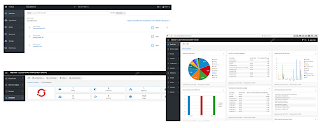 |
| Step 3 - Adding Cloud Operations |
As previously presented in the introduction to this series of articles, you'll be taken through the 10 steps to your cloud happiness.
This journey focuses on the storyline that you're interested due to the push towards a digital transformation and the need to deliver applications in to a cloud service.
This focus on application delivery and all the new moving parts, like containers, cloud, platform as a service (PaaS) and digital journeys might leave you searching for that simple plan to get started. There is nothing like getting hands-on to quickly leverage the experience you've acquired over the years, so let's dive right in.
Previously you were shown how to get a cloud and the use of a service catalog, so what's next?
 |
| Cloud management with Red Hat CloudForms. |
Cloud operations
A cloud is nothing if you can only deliver your applications in to it. This need becomes apparent when trying to manage a diverse landscape of applications, infrastructure and reporting across a hybrid-cloud infrastructure.To give you the feel of solid operations happiness you'll be interested in an open technology based cloud management tool. Managing a complex, hybrid IT environment can require multiple management tools, redundant policy implementations, and extra staff to handle the operations. Red Hat CloudForms simplifies IT, providing unified management and operations in a hybrid environment.
The following provides the Red Hat CloudForms experience by installing it in a container on any OpenShift Container Platform (OCP). Below are the instructions that include installing OCP as outlined in step one of this series called, Get a Cloud.
Install on your machine
- First ensure you have an OpenShift container based installation, such as one of the following installed first:
- OCP Install Demo
- or your own OpenShift installation.
- Download and unzip.
- Run 'init.sh' or 'init.bat' file. 'init.bat' must be run with Administrative privileges:
# The installation needs to be pointed to a running version
# of OpenShift, so pass an IP address such as:
#
$ ./init.sh 192.168.99.100 # example for OCP.
 |
| Add a container provider to start tracking operational metrics. |
The rest of the exploration is left up to the user, as there are many roads to travel when using Red Hat CloudForms.
Rest of the story
If you are looking for the introduction to the 10 steps series or any of the individual steps:So stay tuned as this list's tackled one-by-one over the coming weeks and months to provide you with a clear direction towards your very own application delivery in the cloud happiness.

No comments:
Post a Comment
Note: Only a member of this blog may post a comment.